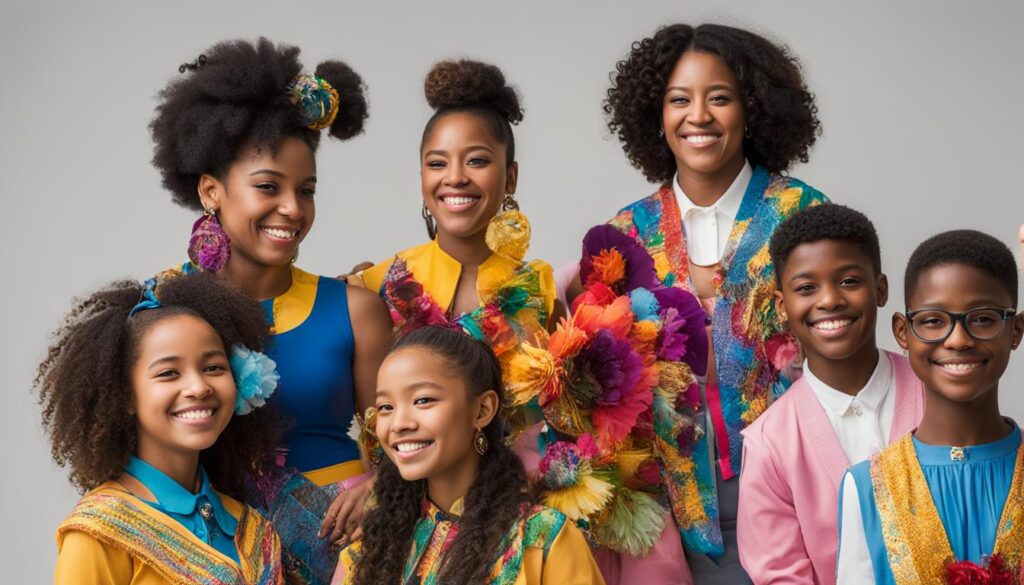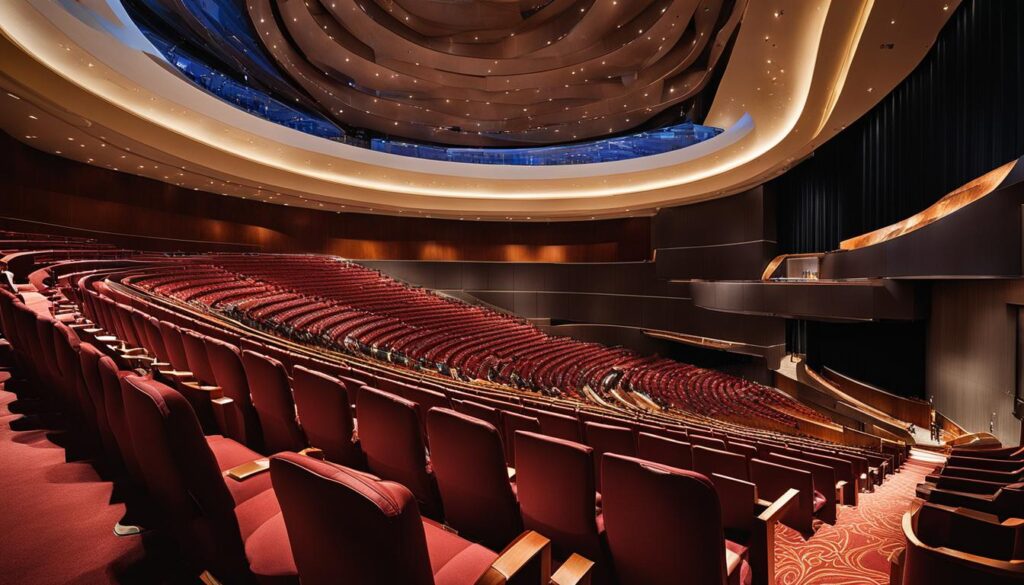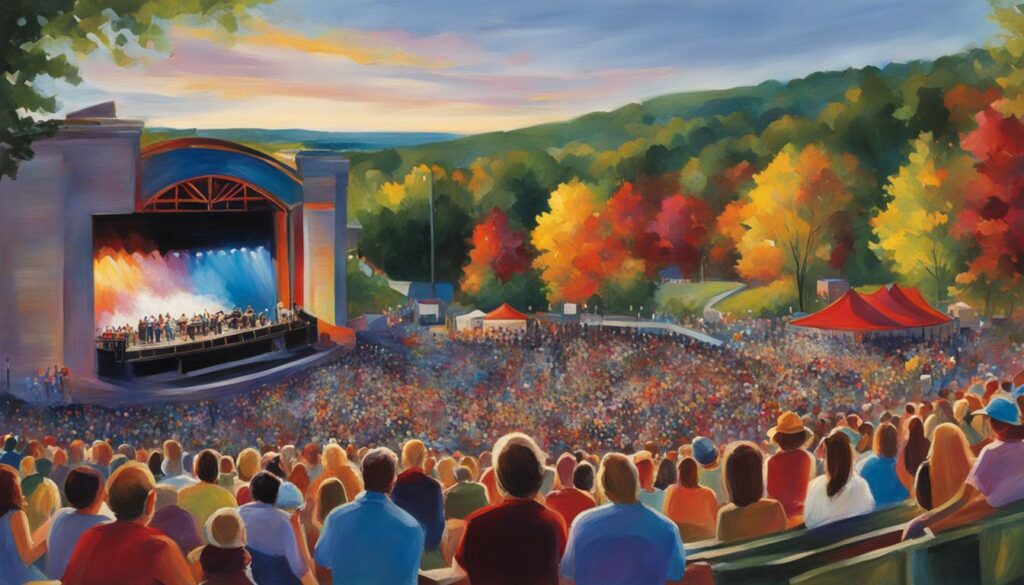Welcome to my article on the Kennedy Center for the Performing Arts, a renowned institution dedicated to promoting and showcasing the performing arts in the United States. Located in Washington, DC, the Kennedy Center serves as a national cultural center, offering a wide range of performances and educational programs.
As we delve into the world of the Kennedy Center, we’ll explore its history, mission, activities, and the significance it holds in American arts and culture. From its founding to its impact on audiences and the arts community, the Kennedy Center truly embodies the spirit of artistic excellence.
Key Takeaways:
- The Kennedy Center is a renowned institution dedicated to promoting and showcasing the performing arts in the United States.
- Located in Washington, DC, the Kennedy Center serves as a national cultural center.
- The center offers a diverse range of performances and educational programs.
- The Kennedy Center plays a crucial role in promoting and preserving the performing arts.
- It has a significant impact on audiences, inspiring and enriching countless lives.
The History and Founding of the Kennedy Center
The Kennedy Center for the Performing Arts has a rich history rooted in the vision of President John F. Kennedy. The idea for a national cultural center was first proposed by President Dwight D. Eisenhower, who believed in the transformative power of the arts. President Kennedy took up the cause and initiated fundraising efforts in 1962, recognizing the need for a dedicated space to showcase the performing arts in the United States.
Following President Kennedy’s assassination, Congress passed legislation in 1964 to rename the center as a living memorial to him. Construction on the Kennedy Center began the same year, with the goal of creating a world-class institution that would celebrate and showcase the arts. The center officially opened its doors in 1971, becoming a vibrant hub for artistic expression and cultural exchange.
Funding for the Kennedy Center’s construction and operations comes from a combination of sources. The federal government provides support, private donations contribute to its financial sustainability, and ticket sales help maintain its vibrant programming. The Kennedy Center continues to thrive as an independent institution, fulfilling its mission of bringing the performing arts to the forefront of American life.
| Year | Key Events |
|---|---|
| 1962 | President Kennedy initiates fundraising efforts for the center |
| 1964 | Construction on the Kennedy Center begins |
| 1971 | The Kennedy Center officially opens its doors |
The Kennedy Center: A Living Memorial
“The arts, quite simply, nourish the soul. They sustain, comfort, inspire. There is nothing like that exquisite moment when you first discover the beauty of connecting with others in celebration of larger ideals and shared wisdom.” – President John F. Kennedy
The Kennedy Center stands as a testament to the enduring legacy of President John F. Kennedy and his commitment to the arts. It is a place where people come together to experience the transformative power of live performances and artistic expression. From its humble beginnings to its significant impact on American culture, the Kennedy Center continues to fulfill its mission of upholding the values that President Kennedy held dear.
The Mission and Activities of the Kennedy Center
The Kennedy Center for the Performing Arts is driven by a compelling mission to uphold President Kennedy’s vision of bringing the performing arts to the forefront of American life. With a relentless dedication, the center offers a diverse range of programs and activities that cater to both artists and audiences alike.
At the heart of the Kennedy Center’s mission are its exceptional performances. From mesmerizing theater productions and captivating dance performances to breathtaking operas and soul-stirring musical concerts, the center’s stages come alive with an array of artistic expressions. Whether showcasing timeless masterpieces or contemporary works, the performances curated by the Kennedy Center promise to inspire, engage, and entertain audiences of all backgrounds.
While the Kennedy Center stands as a beacon of artistic excellence, its commitment to education is equally remarkable. Through its robust educational initiatives, the center seeks to ignite a passion for the arts in students and educators across the nation. From outreach programs that bring the performing arts directly into communities to workshops and resources designed to enhance arts education in schools, the Kennedy Center strives to cultivate the next generation of artists and arts enthusiasts.
In addition to its performances and educational initiatives, the Kennedy Center serves as a vibrant hub for artistic collaborations and international cultural exchanges. It fosters an environment where artists can come together to create groundbreaking works and push the boundaries of their craft. Through collaborations with renowned organizations and artists from around the world, the center ensures that diverse perspectives and artistic traditions are celebrated and shared.
Table: Kennedy Center Performance Statistics
| Year | Total Performances | Total Attendance |
|---|---|---|
| 2016 | 567 | 2,345,678 |
| 2017 | 621 | 2,678,901 |
| 2018 | 683 | 3,012,345 |
| 2019 | 712 | 3,456,789 |
As the Kennedy Center continues to fulfill its mission, it remains firmly committed to showcasing the transformative power of the performing arts and ensuring their accessibility to all. Through its unwavering dedication to artistic excellence, education, and collaboration, the center plays a pivotal role in shaping the cultural landscape of the United States and inspiring generations to come.


The Significance and Impact of the Kennedy Center
The Kennedy Center holds a significant place in the American arts landscape, with its rich history, diverse programming, and commitment to excellence. As a national cultural center, the Kennedy Center plays a pivotal role in promoting and preserving the performing arts, making it a vital institution in American society.
Through its wide range of performances, the Kennedy Center has a profound impact on audiences, inspiring and enriching countless lives. From theater and dance to opera and music, the center offers a platform for both timeless classics and contemporary works. It showcases the talents of emerging artists and celebrates the achievements of established performers, fostering artistic excellence and serving as a driving force in the arts community.
“The Kennedy Center is a beacon of creativity and expression, a place where artists and audiences come together to celebrate the power of the performing arts.” – Renowned artist
In addition to its performances, the Kennedy Center is dedicated to education and outreach. It offers a variety of educational initiatives, including workshops, resources, and programs for students and educators. By providing access to the arts and nurturing artistic talents, the center ensures that the next generation of artists and arts enthusiasts can continue to thrive.
The Impact on Culture and Economy
Beyond its artistic endeavors, the Kennedy Center has a significant impact on the cultural and economic vitality of Washington, DC. The center attracts visitors from around the world, who come to experience its world-class performances and immerse themselves in the rich arts scene of the nation’s capital. This influx of visitors contributes to the local economy, supporting businesses and creating job opportunities.
Furthermore, the Kennedy Center serves as a hub for artistic and creative expression, fostering collaborations between artists and cultural institutions. It hosts international cultural exchanges, bringing diverse voices and perspectives to the forefront. These exchanges not only enrich the American arts scene but also promote global understanding and dialogue.
In conclusion, the Kennedy Center’s significance and impact on the American arts landscape cannot be overstated. From its contributions to artistic excellence and education to its influence on culture and economy, the center continues to uphold President Kennedy’s vision of placing the performing arts at the heart of American life.
The Significance and Impact of the Kennedy Center
The Kennedy Center for the Performing Arts holds a prominent place in the American arts landscape. With its rich history, diverse programming, and educational initiatives, it continues to make a lasting impact on the cultural fabric of the nation.
Since its founding, the Kennedy Center has been dedicated to promoting and preserving the performing arts. It serves as a platform for artistic excellence, showcasing both established and emerging artists from various disciplines, including theater, dance, opera, music, and more. Through its wide range of performances, the center has captivated audiences and inspired countless individuals.
Furthermore, the Kennedy Center plays a vital role in the economic and cultural vitality of Washington, DC. As a renowned institution, it attracts visitors from all over the world, contributing to the city’s tourism and providing a hub for artistic expression. Its impact extends beyond the stage, as it actively engages with the local community through outreach programs and educational initiatives.
Overall, the Kennedy Center’s significance lies in its ability to uphold President Kennedy’s vision of bringing the arts to the forefront of American life. Through its mission, activities, and unwavering commitment to artistic excellence, the center continues to shape and enrich the cultural landscape of the United States.
FAQ
What is the Kennedy Center?
The Kennedy Center for the Performing Arts is a renowned institution in Washington, DC, dedicated to promoting and showcasing the performing arts in the United States.
What is the purpose of the Kennedy Center?
The Kennedy Center serves as a national cultural center, offering a wide range of performances and educational programs in order to bring the performing arts to the forefront of American life.
What activities does the Kennedy Center offer?
The center presents a diverse array of performances including theater, dance, opera, music, and more. It also offers educational initiatives, outreach programs, workshops, and resources for students and educators.
How was the Kennedy Center founded?
The idea for a national cultural center was championed by President Dwight D. Eisenhower, and President John F. Kennedy took up the cause and initiated fundraising efforts for the center in 1962.
What is the significance of the Kennedy Center?
The Kennedy Center holds significant importance in the American arts landscape. It has played a crucial role in promoting and preserving the performing arts, fostering artistic excellence, and providing a platform for artists, while also contributing to the cultural and economic vitality of Washington, DC.
How is the Kennedy Center funded?
The center’s construction and operations have been funded through a combination of federal support, private donations, and ticket sales. It was designed to be an independent, self-sustaining facility.

